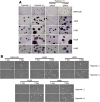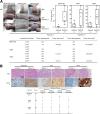Hypoxia-induced cancer stemness acquisition is associated with CXCR4 activation by its aberrant promoter demethylation
- PMID: 30760238
- PMCID: PMC6375212
- DOI: 10.1186/s12885-019-5360-7
Hypoxia-induced cancer stemness acquisition is associated with CXCR4 activation by its aberrant promoter demethylation
Abstract
Background: A hypoxic microenvironment leads to an increase in the invasiveness and the metastatic potential of cancer cells within tumors via the epithelial-mesenchymal transition (EMT) and cancer stemness acquisition. However, hypoxia-induced changes in the expression and function of candidate stem cell markers and their possible molecular mechanism is still not understood.
Methods: Lung cell lines were analyzed in normoxic or hypoxic conditions. For screening among the stem cell markers, a transcriptome analysis using next-generation sequencing was performed. For validation, the EMT and stem cell characteristics were analyzed. To determine whether an epigenetic mechanism was involved, the cell lines were treated with a DNA methyltransferase inhibitor (AZA), and methylation-specific PCR and bisulfite sequencing were performed.
Results: Next-generation sequencing revealed that the CXCR4 expression was significantly higher after the hypoxic condition, which functionally resulted in the EMT and cancer stemness acquisition. The acquisition of the EMT and stemness properties was inhibited by treatment with CXCR4 siRNA. The CXCR4 was activated by either the hypoxic condition or treatment with AZA. The methylation-specific PCR and bisulfite sequencing displayed a decreased CXCR4 promoter methylation in the hypoxic condition.
Conclusions: These results suggest that hypoxia-induced acquisition of cancer stem cell characteristics was associated with CXCR4 activation by its aberrant promoter demethylation.
Keywords: Cancer stem cell; EMT; Hypoxic stimuli; Promoter methylation.
Conflict of interest statement
Ethics approval and consent to participate
Animal experiments were conducted in accordance with the Institutional Animal Care and Use Committee of the Catholic University Medical School guidelines (Approval no. CUMC-2015-0080-01).
Consent for publication
Not applicable.
Competing interests
The authors declare that they have no competing interests.
Publisher’s Note
Springer Nature remains neutral with regard to jurisdictional claims in published maps and institutional affiliations.
Figures






Similar articles
-
TGF-β induced EMT and stemness characteristics are associated with epigenetic regulation in lung cancer.Sci Rep. 2020 Jun 30;10(1):10597. doi: 10.1038/s41598-020-67325-7. Sci Rep. 2020. PMID: 32606331 Free PMC article.
-
The role of hypoxia on the acquisition of epithelial-mesenchymal transition and cancer stemness: a possible link to epigenetic regulation.Korean J Intern Med. 2017 Jul;32(4):589-599. doi: 10.3904/kjim.2016.302. Epub 2017 Jun 30. Korean J Intern Med. 2017. PMID: 28704917 Free PMC article. Review.
-
OVOL2 links stemness and metastasis via fine-tuning epithelial-mesenchymal transition in nasopharyngeal carcinoma.Theranostics. 2018 Mar 8;8(8):2202-2216. doi: 10.7150/thno.24003. eCollection 2018. Theranostics. 2018. PMID: 29721073 Free PMC article.
-
Drug-resistant CXCR4-positive cells have the molecular characteristics of EMT in NSCLC.Gene. 2016 Dec 5;594(1):23-29. doi: 10.1016/j.gene.2016.08.043. Epub 2016 Aug 28. Gene. 2016. PMID: 27581786
-
The mechanism between epithelial mesenchymal transition in breast cancer and hypoxia microenvironment.Biomed Pharmacother. 2016 May;80:393-405. doi: 10.1016/j.biopha.2016.02.044. Epub 2016 Apr 17. Biomed Pharmacother. 2016. PMID: 27133080 Review.
Cited by
-
Long-Term Hypoxia Maintains a State of Dedifferentiation and Enhanced Stemness in Fetal Cardiovascular Progenitor Cells.Int J Mol Sci. 2021 Aug 29;22(17):9382. doi: 10.3390/ijms22179382. Int J Mol Sci. 2021. PMID: 34502291 Free PMC article.
-
Revisiting Epithelial Carcinogenesis.Int J Mol Sci. 2022 Jul 4;23(13):7437. doi: 10.3390/ijms23137437. Int J Mol Sci. 2022. PMID: 35806442 Free PMC article.
-
Demethylation in promoter region of severely damaged hepatocytes enhances chemokine receptor CXCR4 gene expression.Histochem Cell Biol. 2023 Nov;160(5):407-418. doi: 10.1007/s00418-023-02229-x. Epub 2023 Aug 2. Histochem Cell Biol. 2023. PMID: 37532885
-
Tumor Microenvironment Uses a Reversible Reprogramming of Mesenchymal Stromal Cells to Mediate Pro-tumorigenic Effects.Front Cell Dev Biol. 2020 Nov 19;8:545126. doi: 10.3389/fcell.2020.545126. eCollection 2020. Front Cell Dev Biol. 2020. PMID: 33330442 Free PMC article. Review.
-
Epigenetics and metabolism at the crossroads of stress-induced plasticity, stemness and therapeutic resistance in cancer.Theranostics. 2020 May 15;10(14):6261-6277. doi: 10.7150/thno.42523. eCollection 2020. Theranostics. 2020. PMID: 32483452 Free PMC article. Review.
References
-
- Yeo CD, Kang N, Choi SY, Kim BN, Park CK, Kim JW, Kim YK, Kim SJ. The role of hypoxia on the acquisition of epithelial-mesenchymal transition and cancer stemness: a possible link to epigenetic regulation. The Korean journal of internal medicine. 2017;32(4):589–599. doi: 10.3904/kjim.2016.302. - DOI - PMC - PubMed
MeSH terms
Substances
Grants and funding
LinkOut - more resources
Full Text Sources
Medical

